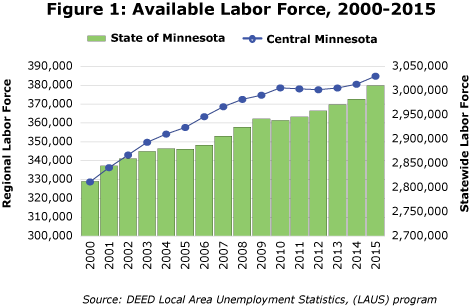

by Luke Greiner and Cameron Macht
June 2016
Employers will need to get used to a tighter labor market in the coming years.
Starting in 1990, Central Minnesota posted strong labor force gains every year until 2010, when that 20-year growth streak abruptly ended. Between 1990 and 1999, the 13-county region’s labor force grew by over 57,500 workers, or 23 percent. From 2000 to 2009, just over 46,000 additional workers increased the labor force by 14 percent. Central Minnesota’s workforce grew more than twice as fast as the state’s during those two decades.
Then a post-recession lull in the region stalled population and job growth. Two years of labor force declines were followed by two years of slow growth, before a return to more rapid expansion. In 2015, the region’s labor force added 4,250 people, reaching a new peak of just under 385,000 workers.
After averaging annual labor force gains of over 5,750 during the 1990s and more than 4,600 in the 2000s, the region has slowed to 1,000 new workers per year since 2010. Moving forward, employers will need to get used to a tighter labor market (see Figure 1).

The recent job growth and economic recovery was especially important in the region, where many counties struggled with high foreclosure rates and residents leaving to find jobs elsewhere. Pine, Chisago, Mille Lacs and Isanti had fewer workers in 2015 than in 2010, while McLeod, Kanabec and Renville have experienced only modest labor force growth since 2010.
Every county in the region saw an increase in the number of employed workers in the past year, while the number of unemployed job seekers declined. Peaking at more than 33,600 in 2009, unemployed workers in the region fell to 15,715 last year, the smallest number of unemployed workers since 2001. Consequently, the region’s unemployment rate dropped to 4.1 percent in 2015, also the lowest on record since 2001.
With 70.9 percent of the population ages 16 and over in the labor force, Central Minnesota has a slightly higher participation rate than the state. Higher than average participation rates among younger workers helped offset the lower rates found in the 55- to 74-year-old cohort (see Table 1).
| Central Minnesota Employment Characteristics, 2014 | |||||
|---|---|---|---|---|---|
| - | Central Minnesota | Minnesota | |||
| - | In Labor Force | Labor Force Participation Rate | Unemployment Rate | Labor Force Participation Rate | Unemployment Rate |
| Total Labor Force | 377,553 | 70.9% | 6.5% | 70.1% | 6.5% |
| Employment Characteristics by Age Group | |||||
| 16 to 19 years | 21,733 | 56.4% | 15.8% | 51.1% | 18.7% |
| 20 to 24 years | 38,112 | 83.6% | 9.6% | 81.8% | 10.2% |
| 25 to 44 years | 155,233 | 88.2% | 6.1% | 88.1% | 5.8% |
| 45 to 54 years | 89,674 | 88.2% | 5.1% | 87.3% | 5.0% |
| 55 to 64 years | 57,741 | 71.4% | 4.8% | 71.8% | 4.9% |
| 65 to 74 years | 12,492 | 25.4% | 4.5% | 26.6% | 4.1% |
| 75 years and over | 2,486 | 6.1% | 2.6% | 5.9% | 3.5% |
| Employment Characteristics by Race and Hispanic Origin | |||||
| White alone | 359,473 | 71.2% | 6.2% | 70.2% | 5.6% |
| Black or African American | 5,104 | 57.9% | 17.8% | 68.0% | 16.4% |
| American Indian | 1,946 | 52.7% | 17.5% | 59.4% | 17.4% |
| Asian or Other Pacific Islanders | 4,368 | 73.4% | 9.5% | 70.6% | 7.2% |
| Some Other Race | 2,745 | 70.4% | 12.8% | 76.2% | 11.0% |
| Two or More Races | 3,831 | 72.4% | 9.6% | 69.5% | 13.2% |
| Hispanic or Latino | 9,605 | 70.6% | 12.4% | 75.0% | 10.1% |
| Employment Characteristics by Disability | |||||
| With Any Disability | 17,942 | 52.1% | 11.8% | 51.0% | 14.0% |
| Source: 2010-2014 American Community Survey, 5-Year Estimates | |||||
Unemployment rates for younger workers in the region are lower than statewide. Teens are most likely to work in lower skill industries like retail and food service, providing a supply of workers just when employers need them during peak summer months. Likewise, entry-level workers from ages 20 to 24 may benefit from a tight labor market where they can build up their skills.
About 65 percent of the workforce in the region is between the ages of 25 and 54, typically considered the prime working years both in terms of earnings and labor force participation rates. The participation rate as well as the unemployment rate of this group was higher than statewide.
While Central Minnesota's middle-aged workforce shrank over the past decade, the region saw a rise in the number of workers 55 and over. Though labor force participation rates are only 25.4 percent for people 65 to 74 and 6 percent for those over 75, the good news is those rates have been climbing.
Central Minnesota's population and workforce are rapidly becoming more diverse. Although 94 percent of the region's residents were white in 2014, the number of blacks has increased by 300 percent since 2000. The number of people of two or more races has jumped 127 percent and the number of Hispanics has surged 96 percent.
At nearly 10,000, Hispanics are the largest minority group in the labor force, accounting for 2.5 percent of the total. While their participation rates are in line with whites, the unemployment rate for Hispanics is twice as high – highlighting the significant disparities that minority workers in the region face. Blacks and American Indians have unemployment rates that are nearly three times higher than the rates for whites and much lower participation rates.
Raising participation rates for these minority groups in line with whites would increase the region's labor force by nearly 2,000, while lowering unemployment rates for all other race groups in line with the white rate could help fill almost 2,000 more jobs with existing workers.
Likewise, people with disabilities face high unemployment rates along with low participation rates, representing a large, untapped pool of opportunity for employers in the region. Cutting the unemployment rate for workers with disabilities in half would fill another 1,050 jobs.
Labor force projections for the region over the next decade, based on current participation rates and population change, show a slight increase (see Table 2). The projected annual average labor force growth of 1,660 pales in comparison with past decades, but it is still the fastest growth of any region statewide.
| Central Minnesota Labor Force Projections, 2015-2025 | ||||
|---|---|---|---|---|
| - | 2015 Labor Force | 2025 Labor Force Projection | 2015-2025 Change | |
| Numeric | Percent | |||
| 16 to 19 years | 26,492 | 26,085 | -407 | -1.5% |
| 20 to 24 years | 40,416 | 46,877 | +6,461 | +16.0% |
| 25 to 44 years | 159,238 | 163,685 | +4,447 | +2.8% |
| 45 to 54 years | 93,194 | 80,121 | -13,072 | -14.0% |
| 55 to 64 years | 65,039 | 74,719 | +9,680 | +14.9% |
| 65 to 74 years | 14,879 | 22,840 | +7,961 | +53.5% |
| 75 years and over | 2,915 | 4,479 | +1,564 | +53.6% |
| Total Labor Force | 402,174 | 418,807 | +16,633 | +4.1% |
| Source: Minnesota State Demographic Center | ||||
The large number of baby boomers will contribute to an aging workforce, with large gains in the number of workers 55 and over against huge declines in the number of workers ages 45 to 54. The region will see increases in the number of 20 to 44 year olds and a slight decline in the number of teenagers. Some forward-thinking companies in the region are embracing flexibility and creative retention policies, such as job sharing, to help keep employees working longer.
Certain industries will be more affected by the aging workforce than others. Across all industries, the number of jobs held by workers 55 and over increased 69 percent in the region over the past decade, from about 36,000 in 2005 to just over 60,600 workers in 2015. The corresponding decline of employment among workers under 25 was just as remarkable, with the youngest cohort dropping from one-in-five jobs in 2005 to just one-in-10 jobs by 2015.
Instead, workers 55 and over now hold more than one-in-five jobs in the region. Only the Twin Cities has a lower share of jobs held by this older cohort. Health care and manufacturing, the two largest industries in the region, employ one-third of the older workers in the region and will face the biggest recruitment and retention challenges (see Table 3).
| Central Minnesota Workforce by Industry, Second Quarter 2015 | |||
|---|---|---|---|
| - | Total Workers | Jobs Held by Workers 55 Years and Over | |
| Number | Number | Percent | |
| Total, All Industries | 273,458 | 60,637 | 22.2% |
| Health Care and Social Assistance | 48,293 | 10,587 | 21.9% |
| Manufacturing | 42,437 | 9,541 | 22.5% |
| Retail Trade | 35,770 | 7,930 | 22.2% |
| Educational Services | 27,554 | 7,726 | 28.0% |
| Accommodation and Food Services | 24,164 | 2,835 | 11.7% |
| Construction | 15,523 | 2,572 | 16.6% |
| Public Administration | 12,751 | 3,238 | 25.4% |
| Wholesale Trade | 10,845 | 2,687 | 24.8% |
| Admin. Support and Waste Mgmt. | 9,599 | 1,909 | 19.9% |
| Other Services | 8,463 | 1,884 | 22.3% |
| Transportation and Warehousing | 8,453 | 3,008 | 35.6% |
| Finance and Insurance | 7,008 | 1,605 | 22.9% |
| Professional and Technical Services | 6,865 | 1,364 | 19.9% |
| Agriculture | 4,522 | 1,027 | 22.7% |
| Information | 3,765 | 946 | 25.1% |
| Arts, Entertainment and Recreation | 2,431 | 431 | 17.7% |
| Real Estate, Rental and Leasing | 1,932 | 582 | 30.1% |
| Management of Companies | 1,726 | 408 | 23.6% |
| Utilities | 1,076 | 302 | 28.1% |
| Mining | 282 | 57 | 20.2% |
| Source: DEED Quarterly Workforce Indicators (QWI) program | |||
The industries with the highest concentrations of workers 55 and over include transportation and warehousing, real estate, educational services, and utilities. Not surprisingly, accommodation and food services had the lowest share of older workers, but even that industry was aging, nearly doubling the share of 55 and older workers from 7 percent to 12 percent in the last 10 years. Every industry will need to react to a rapidly changing workforce.